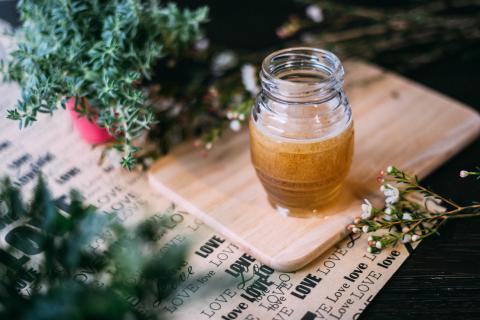
A cordial is a health-promoting, good tasting herbal drink that contains alcohol both as a preservative and solvent for extracting herb and spices. Cordials are generally taken in doses ranging from around 1/2 teaspoon to an ounce. The term derives from the Latin cor, meaning heart. Cordials are said to have originated during the Renaissance, but I would guess that their origins are actually older, given that distillation is an ancient process. Alchemists would add gold flecks to cordials to capture the “cordial vertues” of sun rays, and alchemy itself goes back thousands of years.
Cordial making is fun, especially during this witchy time of year. They’re great to have around for dinners and other social gatherings, to give as gifts, or simply to help you be more compliant in taking your herbs. Cordials can be made for healthy digestion; as a longevity tonic; for heart, liver, kidney and/or lung health; for mood; as an aphrodisiac or for ___?___ (you fill in the blank).
Tincture-Based Cordials
There are a couple of easy ways to make cordials, but it takes a while for the final product, so get started soon if you’re planning on having them around for seasonal or holiday gifts or gatherings. Tincture-based means simply that you’re making a glorified tincture. Though you could skip the actual tincture making part and buy commercial herb or mushroom tinctures to blend with whatever flavorings you want, but where’s the fun in that?
So, to make your own from scratch, you’ll need some sort of alcohol. Brandy is traditionally used, but vodka, gin, tequila or rum also work. These are all 80 proof, translating to 40% ethanol. You can use stronger alcohol, for example certain rums or Everclear, but the goal of a cordial isn’t to get schnockered. You can use a weaker alcohol like port wine, some of which are 20% ethanol, but be careful not to add any additional liquid. The reason is that once the total amount of ethanol goes below 20%, unwanted microbial growth occurs and the cordial will spoil.
How much herb and spice to use depends on whether they are dry or fresh. Properly dried herbs and spices will be more concentrated in terms of medicine and flavor, so you use less. With these, a good starting point is one part herb/spice by weight to 7 parts liquid by volume (more on liquids in a moment). For example, if you were making a rose petal cordial, you would use 1 ounce of rose and 7 ounces of liquid. For the metric geeks out there, this would be about 30 grams of rose to 210 milliliters of liquid. With fresh herbs, fruits, etc., a good starting point is 1 part by weight to 3 parts liquid by volume. The liquid includes the alcohol along with medicinal and/or flavoring ingredients like spice extracts, herbal tinctures, fruit juices, hydrosols (more on these scented waters soon!), honey, or maple syrup.
After combining the ingredients, steep your concoction for 4-8 weeks in a cool place out of direct sunlight, in a cabinet for instance. Give it a good shake when you remember to. Or, to be really witchy (and if the ground isn’t frozen), you can bury it in your yard! The longer the better…6-8 weeks will produce a flavorful and smoother blend. Less time will still result in a flavorful product but it won’t be quite as smooth. Strain, then bottle. There are many online sources of bottles, but some pretty nifty bottles can be found at thrift stores.
Tea-Based Cordial
Another way to make a cordial is to simply make a strong tea and preserve it with alcohol. Start out with 3 teaspoons of dried herbs/spices or 3 tablespoons of fresh per 8 ounces of water.
For softer plant parts like flowers and leaves, boil the water then pour over the dry ingredients. Steep the tea anywhere from 15 minutes to overnight on the countertop (with lid on). The time depends on the ingredients and your own preferences. Steeping just a few minutes won’t cut it, though. You’ll figure out what works best for your particular blend the more you experiment with it.
For roots, seeds, barks, and mushrooms, add them to the appropriate amount of water, using the ratios mentioned above for dry versus fresh. Bring to a boil then reduce the heat and simmer. Again, how long to simmer will depend on the ingredients used. For instance, I simmer roasted dandelion root with a bit of cinnamon for 10 minutes, then remove from heat and steep for another 30 minutes. I simmer mushrooms for at least 2 hours, adding water back as it goes to make up for evaporation.
Strain and mix with enough alcohol so that the final ethanol concentration is 20%, which is necessary for preservation. More is not better, since the more brandy, rum, or whatever you add, the more you dilute your medicinal tea. In any event, this will require some math based on what alcohol you are using (brandy with 40% ethanol or organic cane alcohol with 95% ethanol). At this point, you can add flavorings, for example, dry spices, dried fruit, etc. You’ll have to take into account any additional liquid ingredients like fruit juice, extracts or honey in these calculations (don’t worry, there’s a sample recipe below to orient you!).
As with tincture-based cordials, macerate for 4-8 weeks, then strain.
A Couple of Cordial Recipes
Elderberry Winter Tonic - Tincture Method (~1 part dry herbs & spices to 7 parts liquid)

Ingredients:
0.4 oz Elderberries
0.4 oz Rose Hips
0.3 oz Cacao
1 Vanilla Bean (~0.1-0.2 oz)
6.5 oz Vodka or Brandy
2 oz Black Cherry Juice
1/2 teaspoon Cinnamon Tincture
1 tablespoon Raw Honey ( ~1/2 oz)
Directions:
- Combine all ingredients in a clean jar, mix well.
- Let it macerate.
Cordial for a Sunshiny Mood - Tea Method

Ingredients:
0.5 teaspoon dried Rose Petals
0.5 teaspoon dried Damiana
0.5 teaspoon dried Violet
1 teaspoon dried Lemon Balm
0.5 teaspoon dried Hawthorn Berry
Directions:
- Add hawthorn berries to ~8 oz water (or add an ounce or so extra to account for evaporation). Bring to a boil, reduce heat, and simmer for 10 min. Turn off heat, add other herbs, and steep for 30 min. Strain. This two-step approach is important because harder materials like berries need to be handled differently than soft bits like flowers.
- Measure out 4 oz of tea and add 1/8 tsp Cardamom, 1 slice fresh Ginger, and 1 tablespoon Honey.
- Add 4oz brandy
- Let it macerate.
Other tasty ideas for blends:
•Damn Good Digestive Cordial - Fresh mint, ginger & raspberries
•Kidney Mojo Cordial - Dried guduchi, reishi, cordyceps powder, cacao, vanilla &
black cherry juice
•Happy Heart Cordial - Hawthorn, reishi, cacao, cinnamon & red chile
Put on your pointy hat and get brewing!








